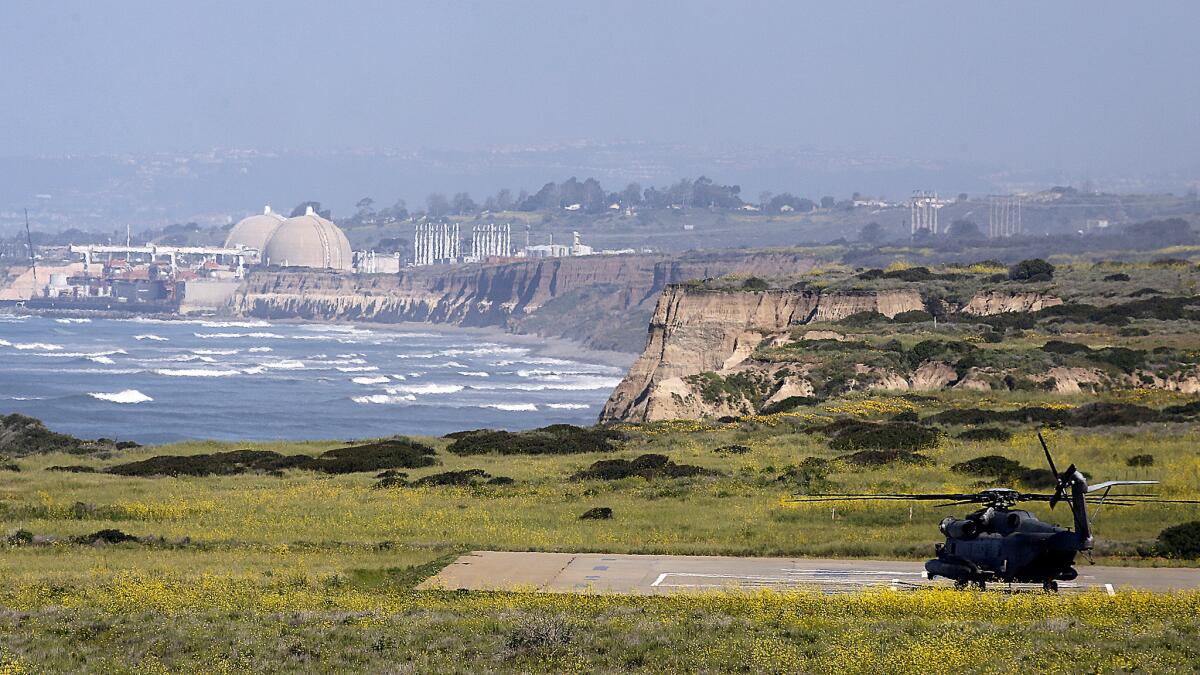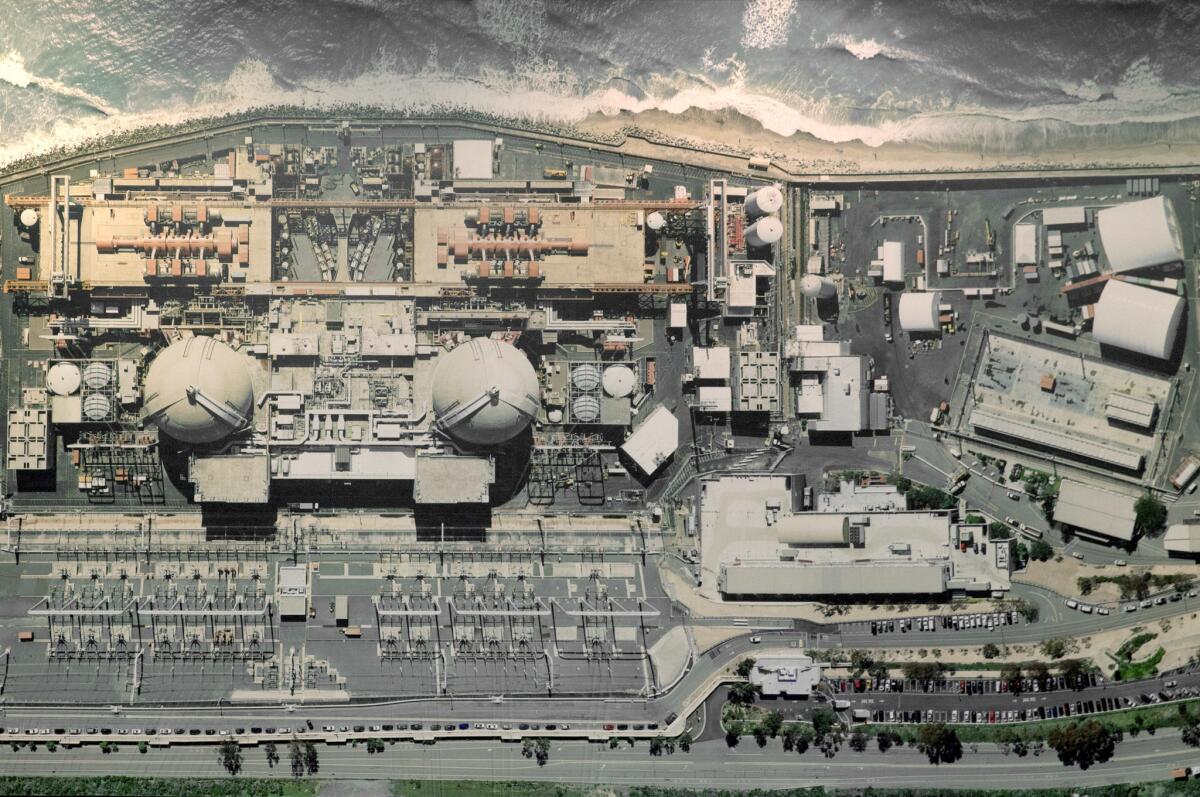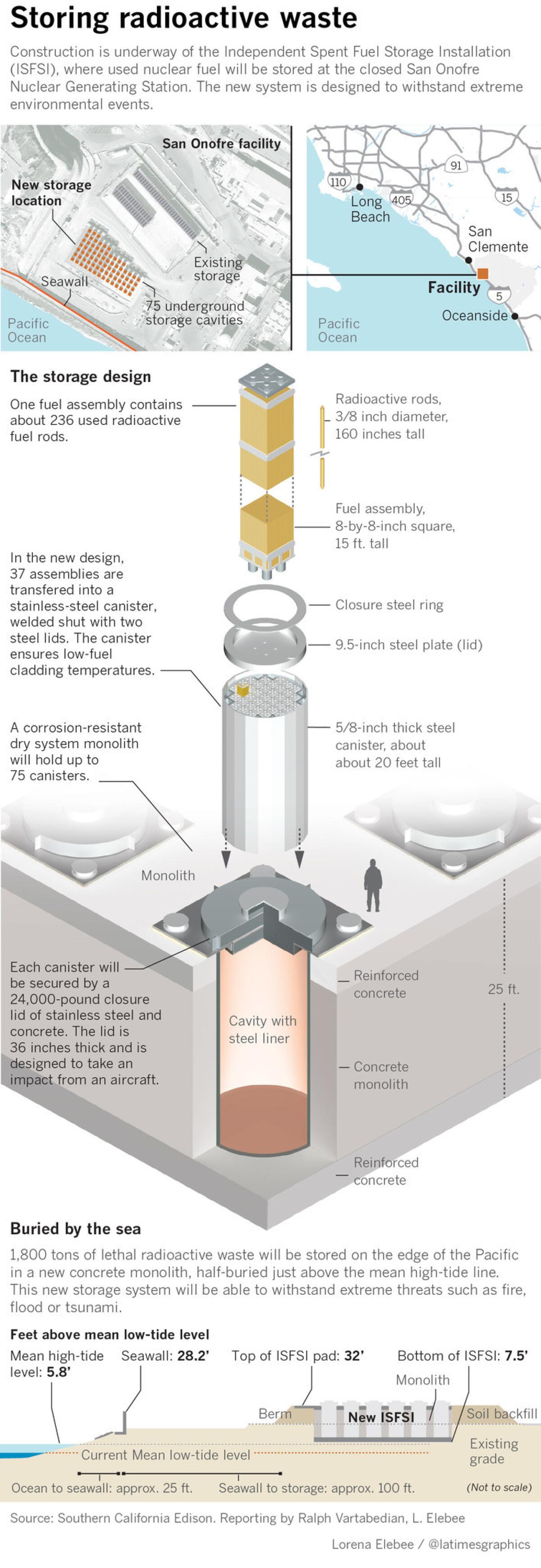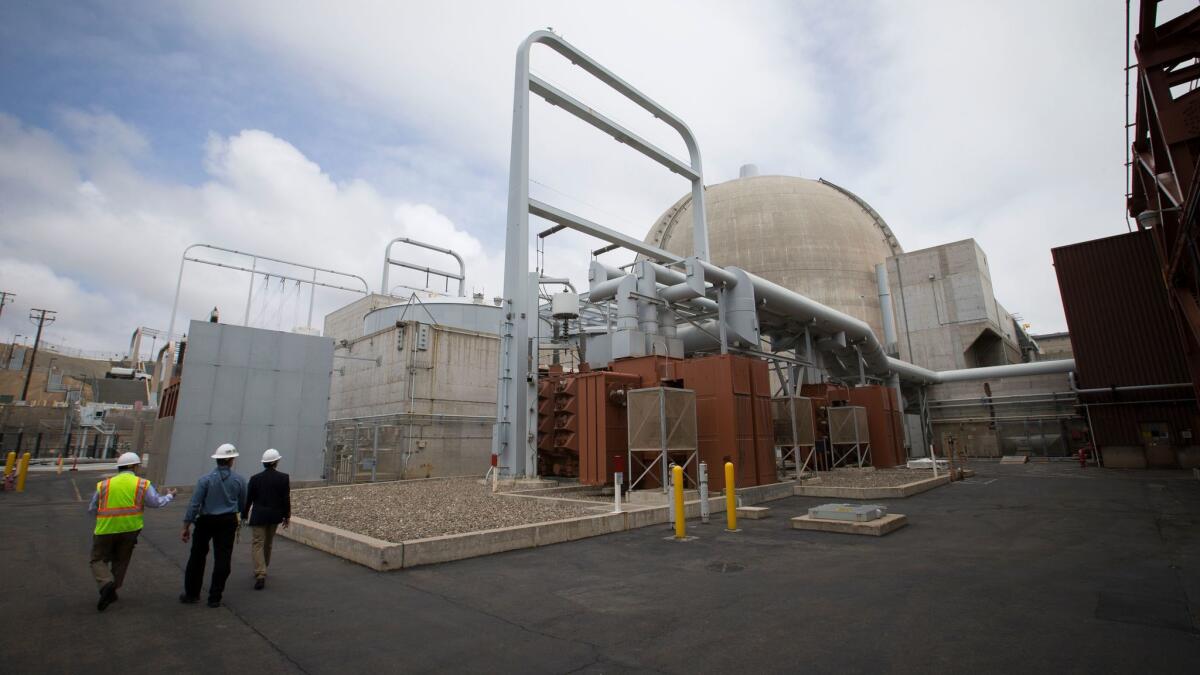1,800 tons of radioactive waste has an ocean view and nowhere to go

- Share via

The massive, 150-ton turbines have stopped spinning. The mile-long cooling pipes that extend into the Pacific will likely become undersea relics. High voltage that once energized the homes of more than a million Californians is down to zero.
But the San Onofre nuclear power plant will loom for a long time as a landmark, its 1,800 tons of lethal radioactive waste stored on the edge of the Pacific and within sight of the busy 5 Freeway.
Across the site, deep pools of water and massive concrete casks confine high-power gamma radiation and other forms of radioactivity emitted by 890,000 spent fuel rods that nobody wants there.
And like the other 79,000 tons of spent fuel spread across the nation, San Onofre’s nuclear waste has nowhere to go.
The nation’s inability to find a permanent home for the dangerous byproduct of its 50-year-adventure in nuclear energy represents one of the biggest and longest running policy failures in federal government history.
Now, the Trump administration and
But the new strategy faces many of the same challenges that have dogged past efforts, leaving some experts doubtful that it can succeed.
America’s nuclear waste failure
The shuttered San Onofre facility — not withstanding its overlook of prime surf breaks — is similar to about a dozen other former nuclear power plants nationwide that now have to babysit waste to prevent natural disasters, human errors or terrorist plots from causing an environmental or health catastrophe.
Though utilities and government regulators say such risks are remote, they have inflamed public fear at least since 1979’s Three Mile Island reactor accident in Pennsylvania.
The sites are located on the scenic shores of northern Lake Michigan, along a bucolic river in Maine, on the high plateau of Colorado and along the densely populated Eastern Seaboard — each environmentally sensitive for different reasons.
No one wants that waste near them — including officials in the sleepy beach town of San Clemente, just north of San Onofre. Even Southern California Edison Co. officials, while insisting the waste is safe, agree it should be moved as soon as possible.
“It doesn’t make any sense to store the fuel at all these sites,” said Thomas Palmisano, chief nuclear officer at the Southern California Edison plant. “The public doesn’t want the spent fuel here. Well, the fuel is here.”
But every attempt to solve the problem almost instantly gets tangled in complex federal litigation and imposes enormous expense on taxpayers.
The Energy Department was legally bound to haul away the waste by 1998 under the Nuclear Waste Policy Act, making the agency about 20 years late in fulfilling its promise. That has saddled utilities with multibillion-dollar costs to store the waste onsite.

As a result, every nuclear utility, including Southern California Edison, has sued to recover its waste storage costs. So far, they have won judgments and settlements of $6.1 billion, and the Energy Department has projected that it may be liable for up to $25 billion more.
But the new plan is fraught with complex legal, political and financial questions, and has yet to be fully defined or vetted among powerful interest groups or receive approval by Congress or survive inevitable court challenges.
The House Energy and Commerce Committee last week overwhelmingly approved legislation that could clear up many legal questions. Similar bills have been introduced in recent years and failed to move ahead, but this legislation has strong bipartisan support and is backed by the White House.
Still, a lot could go wrong with the plan, as it has for every plan for decades.
Two little-known privately held companies, New Jersey-based Holtec International and Texas-based WCS, have unveiled plans and begun licensing applications with the
Company officials and other proponents say such temporary dumps could be opened in as little as three or four years, assuming the licensing goes smoothly. But other nuclear waste experts expect a timetable of 10 to 15 years for a temporary dump and much longer for a permanent repository.
Two dozen antinuclear activist groups and leading environmental nonprofits already have signaled in letters to the NRC that they will dispute the idea of creating temporary consolidated storage sites.
The groups, along with many longtime nuclear waste technical experts, worry that temporary storage will weaken the government’s resolve to build a permanent repository. And they assert the plan would require transporting the fuel twice, first to the temporary site and then to a permanent dump, magnifying transportation costs and the fuel’s exposure to accidents or attacks by terrorists.
“These trains hauling nuclear waste would go right by Trump’s hotel in Las Vegas,” said Marta Adams, a now-retired deputy attorney general in Nevada who is consulting with the state on its renewed legal battle.
Serious business problems cloud the plan. Among the most important is who would own and be legally responsible for the waste once it leaves the utility plant sites.
The federal government promised in the Nuclear Waste Policy Act of 1982 to take ownership at a government-owned dump, but it never authorized such ownership at a temporary private facility — one of the legal questions that the Energy and Commerce Committee’s legislation would clear up.
A temporary facility by Holtec or another organization is intended as a segue to a permanent dump at Yucca Mountain, about 100 miles north of Las Vegas. Along with an interim storage site, the Trump administration wants to restart licensing of Yucca Mountain, which President Obama suspended.
But reviving Yucca Mountain is a long shot. A decade ago, the Energy Department estimated Yucca Mountain would cost nearly $100 billion, a figure that has undoubtedly increased. The cost could be a problem for deficit-minded Republicans.
The Energy Department collected a tiny monthly fee from utility customers to build the dump, and currently a so-called trust fund has $39 billion reserved for the purpose.
But a little known clause in federal budget law 20 years ago decreed that contributions to the trust fund would count against the federal deficit. There are no securities or bonds that back up the fund, unlike the Social Security Trust Fund. As a result, every dollar spent on Yucca Mountain will have to be appropriated, and the money will add to the national debt.
“The money was collected for one purpose and used for another,” said Dale Klein, a former NRC chairman who is now associate vice chancellor for research at the University of Texas. “There is a moral obligation to address the issue. It will be a challenge to get Congress to pay for it.”
The Trump plan has also rekindled the strident bipartisan political opposition of Nevada officials, including the governor, senators, representatives and attorney general, among others. They vow to erect every legal and political obstacle to delay or kill the Yucca Mountain dump.
The state filed nearly 300 formal objections to the plan before the Obama administration suspended licensing. They must be individually examined by the NRC, a process that could take five years.
Then, the design and construction of the underground dump will require construction of about two dozen big industrial buildings and 300 miles of new railroad track. It could cost $1 billion or more every year, ranking among the largest federal operations.
A permanent repository could take 10 years to 20 years by most estimates.
On the beach
Nowhere is the nuclear waste problem more urgent than at shuttered power plants like San Onofre.
After utilities dismantle the reactors, haul away the concrete debris and restore the sites to nearly pristine condition, the nuclear waste remains. Security officers with high-powered automatic weapons guard the sites round the clock.
About five years after the spent fuel rods cool off in a 40- to 50-foot-deep pool, they are transferred to massive steel and concrete dry casks about 20 feet tall. Almost every government and outside nuclear expert considers the dry casks much safer than the pools.
The 3 Yankee Cos., which are safeguarding dry casks at three former New England reactors, spend about $10 million annually per site for maintenance and security, company officials say. The costs could be higher at San Onofre if the waste is left in place, Palmisano said.
Edison is building a massive concrete monolith for more storage, using a Holtec design called Hi-Storm UMAX. It will hold about two-thirds of the plant’s spent fuel in 73 stainless-steel canisters about 125 feet from the ocean. The 25-foot structure is about half-buried with the underground foundation just above the mean high-tide line. Tall cranes and swarms of hard hats are moving construction ahead.
The crucial question is whether it will be safe, especially if congressional inaction or litigation by opposition groups keeps it on-site for years.
“The top has four feet of steel-reinforced concrete,” said Ed Mayer, program director at Holtec. “It is remarkably strong. The … steel lids are designed to take an aircraft impact.”
NRC officials say the design is safe and meets all federal requirements. Although nuclear issues are within the NRC’s jurisdiction, the Coastal Commission also examined the potential for a tsunami, sea level rise or an earthquake to undermine the facility.
“Under our authority, which is limited, the commission approved the permit, and behind that is the evaluation that it is safe for a period of 20 years,” said Alison Dettmer, deputy director of the commission.
But suspicion lingers. San Clemente city officials have demanded that the fuel be removed as soon as possible. An activist group, Citizens’ Oversight, has sued Edison for starting construction and the California Coastal Commission for approving it.
The waste “is right down by the water, just inches from the high-tide line,” said Ray Lutz, the group’s founder. “It is the most ridiculous place they could find.”
In an effort to assuage local concerns, Edison participates in a “community engagement panel” that meets at least quarterly, led by UC San Diego professor David Victor.
“Early on, I was surprised by how many people did not understand there was no place for the fuel to go,” he said. Over the last year, the possibility of a temporary storage site has raised people’s hopes for a quicker solution, he said.
The history of nuclear waste, however, is replete with solutions that seem plausible but succumb to obscure and unanticipated legal, technical or financial issues.

Decades of delay
Two decades ago, the Skull Valley Band of Goshute Indians sought to create an interim storage facility for nuclear waste on its reservation about an hour out of Salt Lake City.
The NRC spent nine years examining the license application and approved it. But Utah officials and a broad swath of major environmental groups opposed the plan. Eventually, the state blocked shipping routes to the reservation.
Michael C. Layton, director of the NRC’s division of spent fuel management, said a temporary facility would use the same technology as existing dry cask storage sites, like San Onofre.
But Layton said it is unclear how long it will take to license a consolidated storage site. The formal review is scheduled for three years, but the Skull Valley license that took nine years is the only actual licensing effort to compare it to, he added. Palmisano, the Edison executive, estimates that an off-site temporary storage facility could be operating in 10 to 15 years.
Problems have already delayed WSC, which wants to build a storage site in Andrews, Texas. It asked the NRC in April to suspend its license application.
The $7.5-million cost of just the license application review “is significantly higher than we originally anticipated,” the company said, noting that it is under additional financial stress because the Justice Department has sued it to block a merger.
Holtec officials say that WCS’ problems haven’t deterred their plans for an underground storage site, saying interim storage could save the federal government billions of dollars, particularly if the Yucca Mountain plan is again postponed.
The company has strong support in New Mexico, which already has a dump for nuclear weapons waste, a uranium enrichment plant, a nuclear weapons armory and two nuclear weapons laboratories.
“We are very well-informed,” said Sam Cobb, mayor of nearby Hobbs, rejecting arguments by antinuclear groups that the industry preys on communities that need money and don’t understand the risk.
“It is not a death grab to get money,” he said. “We believe if we have an interim storage site, we will be the center for future nuclear fuel reprocessing.”
Transportation to an interim site would cost the federal government billions of dollars under the pending legislation. Aides at the House Energy and Commerce Committee said those costs would be recovered when the federal government no longer has to pay for legal settlements for failing to take the waste in the first place.

Even if an interim site is built, it is uncertain who would get to ship waste there first. The timing of waste shipments to a permanent site is determined by the so-called standard contract queue, a legal document so complex that federal bureaucrats have dedicated their entire careers to managing it.
The queue was structured so that the oldest waste would go into a future dump first. In the unlikely event that Yucca Mountain were opened in 2024, Edison’s fuel would be in line to start shipping in 2028 with the last bit of waste arriving in 2049, Palmisano said.
Whether that queue would apply to an interim site is unclear, even under the pending legislation.
The dry casks are designed to keep spent fuel confined only for decades, while the health standard for a permanent repository covers hundreds of thousands of years — longer than humans have roamed Earth. If the radioactive waste sits around in temporary storage for hundreds of years, it could be neglected and eventually forgotten.
So one outcome that nobody seems to want is for a temporary site to eventually become permanent by default.
“It would derail momentum for a permanent repository,” said Edwin Lyman, a nuclear physicist at the Union of Concerned Scientists. “This issue has always pitted one community against another and those in between.”
Twitter @rvartabedian
Twitter @alschaben
ALSO
A trial by imaginary fire for women who want to fight real wildland flames
Political Road Map: Gov. Jerry Brown's wall of debt has crumbled, but there are more walls behind it
Las Vegas adds a new lure to its repertoire as Nevada legalizes pot. Here come the tourists
Sign up for Essential California
The most important California stories and recommendations in your inbox every morning.
You may occasionally receive promotional content from the Los Angeles Times.








